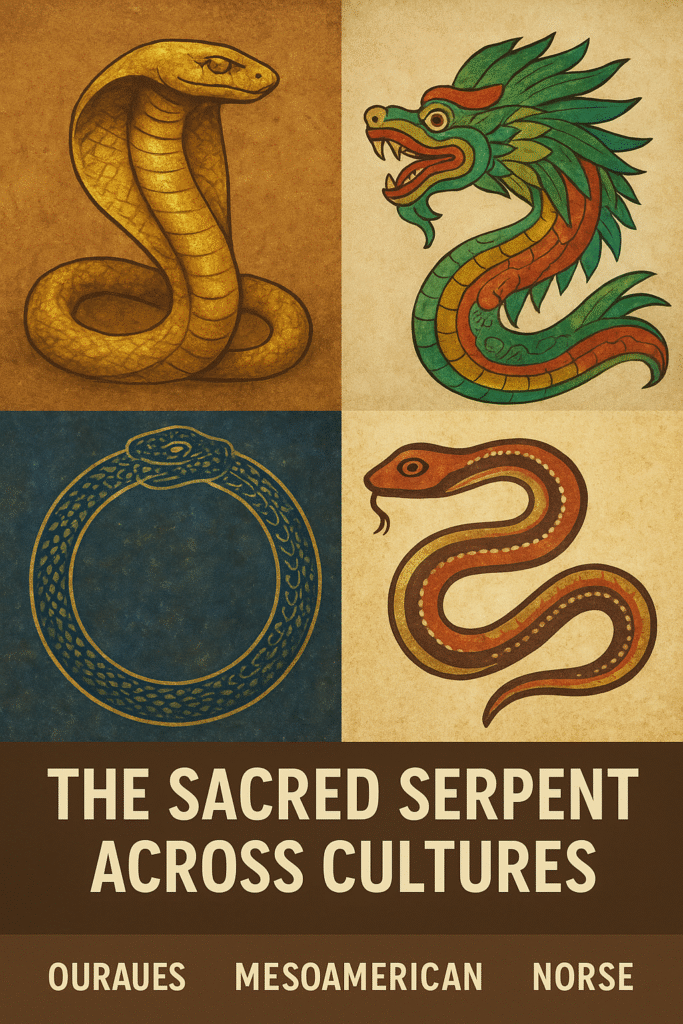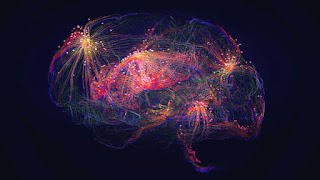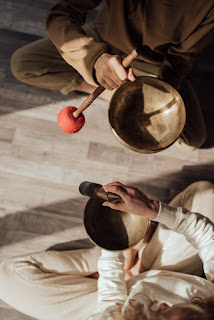The Sacred Serpent: Kundalini Energy in World Mythologies

“Within the coil of the serpent lies the secret of awakening—the power to shed, to rise, and to remember.”
Introduction: The Serpent That Sleeps Within
Across centuries and continents, one image has slithered through myth, art, and spirit alike—the serpent. Mysterious, feared, and revered, it has long symbolized transformation, wisdom, and the cyclical nature of life. In yogic philosophy, the serpent takes a sacred form known as Kundalini—the coiled divine energy that rests dormant at the base of the spine, waiting to awaken and ascend through the body’s energy centers.
Though rooted in Indian spirituality, the story of the serpent as life force is far older and more universal than any one tradition. It appears in temples and tombs, carved into ancient stones and whispered in creation myths. Every culture has, in its own way, understood the serpent as both a keeper of knowledge and a guide to transcendence.
For as long as I can remember, I’ve felt an inexplicable connection to snakes—their silent grace, their calm vigilance, their gift of renewal. I’ve always admired the way they shed their skin, leaving behind what no longer serves them. In many ways, I’ve done the same—shedding old identities, beliefs, and eras of self to emerge anew. Perhaps that’s why the serpent’s symbolism has always felt like home: it reminds us that transformation is not only possible—it’s essential.
The Coiled Power: Kundalini in Yogic Tradition
In the ancient Indian spiritual sciences, Kundalini means “coiled one.” It is the sleeping serpent at the root of our being—Shakti, the divine feminine power that fuels existence itself. Yogic texts describe Kundalini as a luminous energy coiled three and a half times at the base of the spine, waiting for the moment of awakening.
When activated through meditation, breathwork, devotion, or disciplined spiritual practice, this energy rises through the sushumna nadi—the central energetic channel—piercing the chakras one by one. As it ascends, it purifies, energizes, and expands consciousness. The journey is both mystical and physiological: it reshapes how we feel, think, and perceive the world.
Yet Kundalini is not just a practice—it’s a living metaphor. The serpent rising through the chakras represents the unfolding of awareness, the journey from the instinctual base of survival to the crown of divine unity. It is the soul remembering itself as infinite.
In this way, Kundalini embodies the very essence of transformation—the shedding of ignorance for insight, the transcendence of form into spirit.
The Universal Serpent: Threads of a Global Myth
The serpent doesn’t belong to one story—it belongs to all of them. Across cultures, it carries remarkably similar meanings: life force, healing, wisdom, and rebirth. And yet, in every tradition, the serpent takes on a unique expression of that universal truth.
Below are glimpses of the serpent as it moves through myth, a sacred thread winding through humanity’s shared imagination.
Much like the serpent sheds its skin, the awakening of Kundalini represents a shedding of old selves, a theme that resonates with the archetypal motifs discussed in our exploration of yoga mythology.

Egypt – The Uraeus: Fire of the Divine Eye
Symbol of divine protection and awakened sight.
In ancient Egypt, the serpent was a solar emblem—coiled on the brow of gods and pharaohs, radiating power and awareness. The Uraeus, a rearing cobra, adorned royal crowns as a living flame of divine consciousness. It symbolized Wadjet, the serpent goddess who guarded the sun god Ra, striking down enemies and illuminating truth.
Here, the serpent is not feared—it is enthroned. It represents the energy that awakens vision, burns through illusion, and protects divine order. Much like Kundalini rising to the ajna chakra, the Uraeus symbolizes sight beyond sight—the third eye opening.
Greece – The Serpent of Healing and Wisdom
Shedding as renewal, wisdom as medicine.
In Greek mythology, serpents coil around the staff of Asclepius, god of healing. The intertwined form became a timeless symbol of medicine and restoration. To the Greeks, the snake’s shedding of skin mirrored the body’s ability to heal and regenerate. It was the living emblem of metamorphosis.
The serpent was also sacred to Athena, goddess of wisdom, who kept one as her familiar. To hold a serpent’s wisdom was to hold the balance between intellect and intuition, mind and mystery.
Like Kundalini energy, Greek serpent lore speaks of a force that heals, transforms, and renews from within—a medicine not of the body alone, but of consciousness itself.
Mesoamerica – Quetzalcoatl: The Feathered Serpent
Union of earth and sky, body and spirit.
In Aztec and Toltec mythology, Quetzalcoatl, the Feathered Serpent, bridges heaven and earth. His name itself is a union of opposites—quetzal (bird, sky) and coatl (serpent, earth). Together, they represent the synthesis of spirit and matter.
Quetzalcoatl is both creator and redeemer—a bringer of knowledge, culture, and balance. His myth parallels the Kundalini’s path through the chakras: a journey from the grounded base of existence toward celestial consciousness.
In Mesoamerica, as in India, the serpent rises—not to conquer, but to unite.
Norse and Celtic Traditions – The Serpent as Cycle Keeper
Guardian of boundaries, teacher of balance.
In Norse mythology, the serpent takes a cosmic form as Jörmungandr, the World Serpent, encircling the earth and biting its own tail. This ouroboros—the serpent devouring its tail—represents eternity, the endless cycle of death and rebirth.
Similarly, Celtic symbology revered the serpent as a creature of earth energy and healing. Carvings found at ancient stone sites depict serpents as sacred beings of the land, connecting the underworld and the divine.
The ouroboros is perhaps the most universal symbol of Kundalini: energy folded upon itself, eternal and self-renewing.
Africa and Indigenous Traditions – Serpent Spirits of Water and Fertility
The flowing current of life itself.
Across the African continent, serpents often embody water, fertility, and divine movement. In West African Vodun and Haitian traditions, Damballah is the sky-serpent, creator of life and source of cosmic order. His coiling around the world mirrors the spiral of Kundalini around the spine—a sacred geometry of creation.
Among the Aboriginal peoples of Australia, the Rainbow Serpent governs rain, fertility, and the flow of life through the land. This serpent is both creative and destructive, reminding us that true life force holds both power and humility.
Everywhere, the serpent symbolizes the unseen rhythm of existence—the pulsing river of energy that sustains all forms of life.
Common Threads and Contrasts: What the Serpent Teaches Us
When we step back and view these myths together, a pattern emerges. Despite vast differences in culture and geography, the serpent carries a shared essence.
Common threads across cultures:
- Renewal: The shedding of skin mirrors transformation, rebirth, and healing.
- Wisdom: Serpents guard sacred knowledge and spiritual awakening.
- Power: They embody primal energy—both creative and destructive.
- Balance: Serpents unite opposites—heaven and earth, death and life, spirit and matter.
Contrasts that reveal depth:
- In Eastern traditions, the serpent’s energy is inward and ascendant (Kundalini).
- In Western myth, it often appears as externalized—guardian, healer, or tempter.
- Some myths revere the serpent as sacred; others fear it as chaos. Yet even in opposition, it remains the same symbol—the power that can either destroy or enlighten, depending on how it’s met.
The serpent, then, is not good or evil. It is potential—the raw current of transformation itself.
The symbolism of the serpent, as explored in our previous article on How Yoga Poses Reflect Ancient Myths, offers profound insights into the transformative journey of Kundalini awakening.
The Misunderstood Serpent: From Fear to Reverence
As the world moved toward monotheism, the serpent’s symbolism began to shift. In the Book of Genesis, the serpent tempts Eve with knowledge, marking it as a symbol of deception and sin. But even in that story, something deeper stirs: the serpent is the messenger of awakening—the one who offers consciousness, however dangerous it may be.
Over time, humanity learned to fear what it could not control. The serpent became the shadow of divine power, its wisdom buried beneath dogma. But as spiritual awareness expands again, many are rediscovering the serpent’s sacred truth.
Kundalini represents that reclamation—the return of the divine feminine, the embodied wisdom that rises from within rather than descending from above. It’s the remembering of what the ancients always knew: that life’s greatest power moves not in straight lines, but in spirals.
Modern Reflections: The Return of the Serpent
Today, the serpent rises again—this time not in temples or myths, but within hearts. Yoga, breathwork, and meditation are modern vessels for ancient energy. More and more people are experiencing the subtle currents of Kundalini, whether they name it or not: the pulsing aliveness that comes from being fully present, fully awake.
To awaken Kundalini is not to chase an experience but to enter relationship—with the energy of life itself. It’s the process of becoming porous to divinity, of letting consciousness spiral upward through the chambers of the body and soul.
When we see the serpent not as a threat but as an ally, we begin to embody what myth has whispered all along: awakening is not an ascent away from life, but a deepening into it.
Conclusion: The Serpent That Still Lives
The serpent has always been more than a creature—it is a symbol, a mirror, a current. In every culture, it invites us to shed what we’ve outgrown, to release the skins that no longer fit.
To honor the serpent is to honor transformation itself. Whether we call it Kundalini, Shakti, Quetzalcoatl, or Rainbow Serpent, the message remains the same: the divine energy that shapes the cosmos also lives within us.
It waits—coiled, luminous, and patient—for the moment we are ready to awaken.
“And when the serpent rises, it is not the end of the old self—it is the beginning of everything that has always been.”





